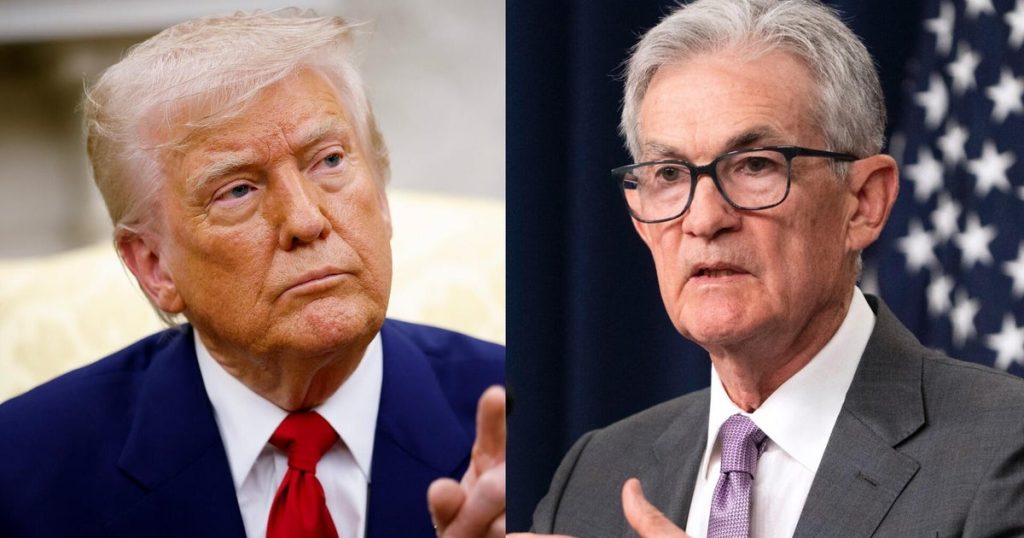In a significant meeting at the White House, Federal Reserve Chairman Jerome Powell discussed economic policies with President Donald Trump on Thursday. This meeting follows months of pressure from the President for the Federal Reserve to lower interest rates. As ongoing economic challenges persist, Powell reiterated the independence of the Federal Reserve in making its monetary policy decisions based solely on economic data.
| Article Subheadings |
|---|
| 1) Overview of the Meeting |
| 2) Economic Context and Challenges |
| 3) The Fed’s Policy Independence |
| 4) Market Reactions and Future Implications |
| 5) Summary and Future Outlook |
Overview of the Meeting
The meeting between Chairman Jerome Powell and President Donald Trump was convened at the President’s invitation, highlighting the ongoing dialogue between fiscal and monetary policymakers in the United States. The primary agenda was to address economic growth and explore ways to stabilize market conditions amidst a complex financial landscape. Powell conveyed the Federal Reserve’s commitment to making informed decisions based on an objective analysis, emphasizing that the central bank operates without political bias. This reassurance comes after considerable pressure from the President, who has publicly criticized Powell’s leadership in monetary policy.
Economic Context and Challenges
The backdrop for this high-profile meeting is a U.S. economy grappling with numerous challenges, including trade uncertainties due to tariffs imposed by the Trump administration. Recent rulings from a U.S. trade court that determined broad tariffs to be illegal have exacerbated concerns among businesses and investors. Moreover, inflationary pressures have been observed as retailers raise prices in response to the increased costs associated with tariffs. The conflict between supporting economic growth and managing inflation remains a critical concern for policymakers.
In recent public remarks, President Trump has actively sought to persuade the Federal Reserve to lower interest rates. His remarks and social media posts have underscored a growing impatience, often expressing dissatisfaction with the Fed’s current rate policies. The market has watched these developments closely, as lower interest rates typically stimulate economic activity by making borrowing more affordable.
The Fed’s Policy Independence
Powell has been steadfast in defending the Federal Reserve’s independence, making it clear that decisions will be based strictly on economic conditions rather than political preferences. He stated, “The path of policy will depend entirely on incoming economic information.” This posture aims to provide credibility to the Federal Reserve, ensuring that it is perceived as a reliable institution focused on its dual mandate of maximum employment and price stability.
Throughout this week, Powell reaffirmed that he has never requested a meeting with a sitting President, emphasizing that it is the President who typically seeks discussions with the Fed Chairman. Such declarations may be essential to maintaining the impression of objectivity and the untainted nature of the Fed’s decisions, especially amid rising political tensions and criticisms from the Executive branch.
Market Reactions and Future Implications
Market investors and analysts have been closely monitoring these developments, questioning how Powell’s meeting with the President may influence the Federal Reserve’s next steps regarding interest rates. The volatility of the stock market reflects the uncertainty stemming from ongoing trade disputes and shifting monetary policy. An indication of further rate cuts could potentially stimulate market growth, whereas a continuation of current policies may lead to further financial market skepticism.
While traders have expressed hopes for an easing of interest rates, the Federal Reserve must balance this with the findings from economic indicators such as employment rates, consumer spending, and inflation metrics. Any drastic moves away from the current policy framework could have significant ramifications for economic stability and growth.
Summary and Future Outlook
Looking forward, the future of U.S. monetary policy remains in a state of flux, with factors such as trade policies and inflation continuing to play pivotal roles in decision-making. The Federal Reserve’s next moves are anticipated to be significantly informed by economic data from the upcoming months, as the organization attempts to navigate the delicate landscape of fiscal pressures and economic growth.
As the dialogue between the White House and the Federal Reserve continues, both entities must remain focused on their respective roles within the economy. The challenge ahead lies in reinforcing the independence of monetary policy while addressing the immediate concerns raised by fluctuating economic conditions.
| No. | Key Points |
|---|---|
| 1 | Federal Reserve Chairman Jerome Powell met with President Donald Trump to discuss economic policies. |
| 2 | The President has consistently pressured the Fed to cut interest rates amid ongoing economic challenges. |
| 3 | Powell emphasized the importance of the Fed’s independence in making monetary policy decisions. |
| 4 | Market responses to the meeting reflect uncertainty regarding future economic policy directions. |
| 5 | The discussion underscores the balance between political pressures and the necessity for data-driven decisions. |
Summary
The meeting at the White House between Jerome Powell and Donald Trump highlights ongoing tensions between monetary policy independence and political influence. As uncertainties from trade policies and inflationary pressures loom heavily on economic growth, the decisions made by the Federal Reserve in the coming months will play a critical role in shaping the U.S. economy. Through careful analysis of incoming data, Powell and the Fed’s leadership aim to uphold their mandate while navigating the challenges posed by the political landscape.
Frequently Asked Questions
Question: What topics were discussed in the meeting between Powell and Trump?
The meeting focused primarily on economic growth, monetary policy, and the impact of ongoing trade uncertainties.
Question: How does the Federal Reserve ensure its policy independence?
The Federal Reserve maintains its independence by making decisions based on economic data rather than political pressure, as emphasized by Chairman Powell.
Question: What are the potential consequences of lowering interest rates?
Lowering interest rates may stimulate economic activity by making borrowing cheaper; however, it risks increasing inflation if not managed carefully.
